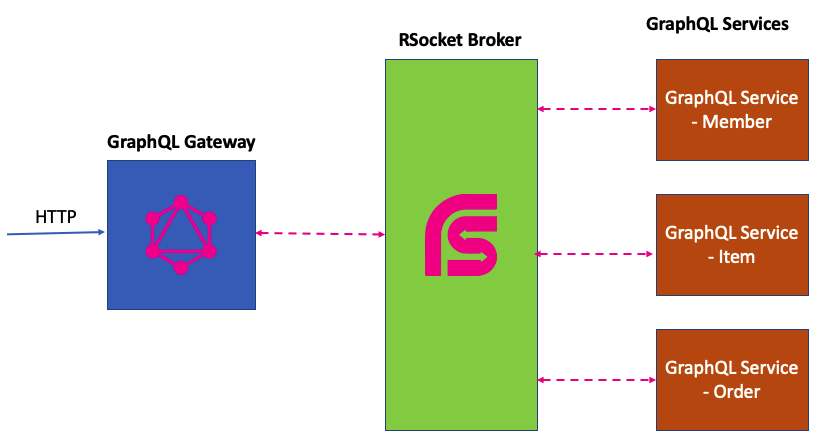RSocket GraphQL Gateway is an HTTP entrance to access GraphQL Services that register on RSocket Broker.
- Load balance support for GraphQL Service
- Access GraphQL Service by RSocket
- Query merge support
- rsocket-graphql-gateway: 基于RSocket的GraphQL HTTP Gateway
- graphql-service-provider: GraphQL的RSocket服务提供者,使用Netflix DGS框架
- graphql-rsocket-support: 支持GraphQL服务快速接入到RSocket Broker
- Start the RSocket Broker:
docker-compose up -d - Start the graphql-rsocket-provider
- Start the rsocket-graphql-gateway
- Please visit index.http and test
对于GraphQL来说,服务接口非常简单,就是 "com.alibaba.rsocket.graphql.GraphqlRSocketExecutor",所有的GraphQL服务都是以该接口对外发布。 那么不同的GraphQL服务如何来区分,如会员和商品就是不同的GraphQL服务分组。 这里我们使用RSocket服务的group概念,不同GraphQL服务分组使用不同的group, 如果会员GraphQL服务使用"user" group, 商品GraphQL服务使用"item" group,这样我们就可以区分开不同的服务。
在GraphQL Gateway,我们也使用分组作为服务的namespace,具体解释如下:
- namespace: 如
user,对应于GraphQL的服务分组, 在Gateway上对应的HTTP地址为http://localhost:8383/user/graphql - routing: 不同的namespace会路由到对应的服务提供者
如何设置GraphQL服务的分组信息? 如何将GraphQL对应的schema提交给RSocket Broker? 你只需要在application.properties 添加以下设置:
rsocket.group=user
rsocket.metadata.graphqls=classpath:schema/schema.graphqls
DGS 4.2.0版本后添加了Data Fetch的Mono/Flux返回类型支持,所以Reactive就内置啦,样例代码如下:
@DgsQuery(field = "bookById")
public Mono<Book> bookById(@InputArgument String id) {
Book book = BOOKS.get(id);
if (book == null) {
return Mono.empty();
} else {
return Mono.just(book);
}
}
如果是列表类型,返回Flux就可以啦。
- 异步执行graphQL.executeAsync(),将 CompletableFuture 转换为Mono
public Mono<Object> execute(ExecutionInput executionInput) {
CompletableFuture<ExecutionResult> future = graphQL.executeAsync(executionInput);
return Mono.fromFuture(future).map(ExecutionResult::getData);
}
- DataFetcher with CompletableFuture Generic type
public DataFetcher<CompletableFuture<Map<String, Object>>> bookById() {
return dataFetchingEnvironment -> {
String bookId = dataFetchingEnvironment.getArgument("id");
return Flux.fromIterable(BOOKS)
.filter(book -> book.get("id").equals(bookId))
.next()
.toFuture();
};
}
通过这两种方式,就可以非常方便地支持GraphQL查询的异步化。当然CompletableFuture和Reactive之间转换也就非常简单啦。
- 查询所有GraphQL服务提供方的schema结构,确保这些服务提供方的GraphQL schema不会冲突。
- 通过调用GraphQL服务提供方的API完成对相关服务的验证。
- 当请求到达gateway时,Gateway要负责基于Query/Mutation完成对应的服务匹配
- 并行执行服务调用,等待服务响应。可以考虑Reactive方案,也就是flatmap。
- 对响应的数据进行合并处理,然后返回给请求方;如果有错误的话,也要进行返回。
我们只需要执行TypeDefinitionRegistry的merge操作即可。
TypeDefinitionRegistry typeDefinitionRegistry1 = new SchemaParser().parse(schema1);
TypeDefinitionRegistry typeDefinitionRegistry2 = new SchemaParser().parse(schema2);
TypeDefinitionRegistry mergedDefinitionRegistry = typeDefinitionRegistry1.merge(typeDefinitionRegistry2);
对应GraphQL Gateway来说,其本身并不程度具体的GraphQL请求执行,而是将请求转发给下游的GraphQL服务方,这个时候只需要为Type类型提供一个默认的DataFetcher,然后该默认的DataFetcher再和远程GraphQL进行交互,完成数据的返回,如下:
RuntimeWiring runtimeWiring = RuntimeWiring.newRuntimeWiring()
.type("Query", builder -> builder.defaultDataFetcher(dfe -> { ... }))
.build();
Gateway会维护一个合并后的大的GraphQL Schema,所以对每一个Query/Mutation请求来说,Gateway都能跟踪到query field的原始来源,然后再将请求发给远程的GraphQL服务即可。
- Alibaba RSocket Broker: https://github.com/alibaba/alibaba-rsocket-broker
- GraphQL Specification: https://spec.graphql.org/June2018/
- GraphQL Java: https://www.graphql-java.com/
- Netflix DGS: https://netflix.github.io/dgs/
- Spring GraphQL: https://github.com/spring-projects/spring-graphql
- How Netflix Scales its API with GraphQL Federation: https://netflixtechblog.com/how-netflix-scales-its-api-with-graphql-federation-part-1-ae3557c187e2 https://netflixtechblog.com/how-netflix-scales-its-api-with-graphql-federation-part-2-bbe71aaec44a
